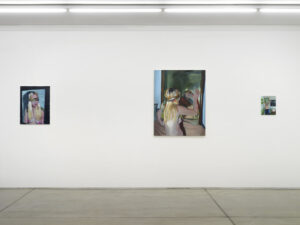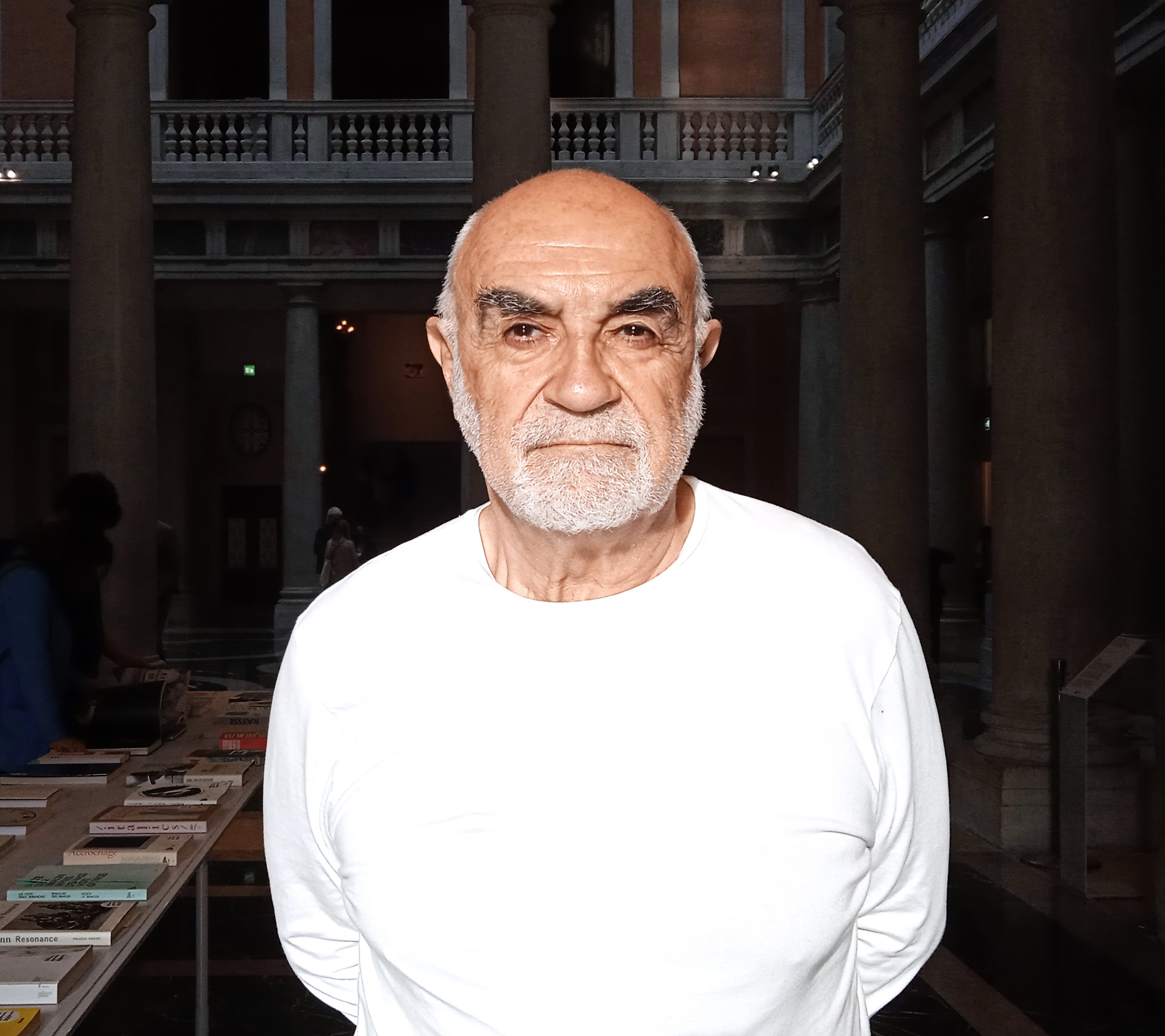Opposing the confusion between facts and fictions, questioning what and how we see, i.e. the power relations implied by the way in which information is mediated and communicated: these are the explicitly political objectives that must be pursued even in painting. Jenna Gribbon, born in 1978 in Knoxville, Tennessee, moved to New York at the age of twenty-four, is convinced of this at her first solo exhibition in a European institution at the Maramotti Collection in Reggio Emilia. Thus, in effect, the painter expresses herself in a video (click here) in which the dozen paintings exhibited in the Pattern Room of the Collection are presented.

Jenna Gribbon, In bed with a mirror, 2022, oil on linen, 122 x 96,5 cm, photo Dario Lasagni, courtesy of the artist and MASSIMODECARLO
Gribbon traces her most decisive political commitment back to 2016, at the time of the Trump elections in the United States, an event evidently experienced as disastrous by the painter, proudly belonging to that universe now known under the LGBTIQ+ variable-length label. In fact, the exclusive subject of her paintings is her life partner, the musician Mackenzie Scott, now portrayed in very large paintings, larger than any observer, now in tiny remakes of small photos where the woman is caught in fleeting everyday moments.

Jenna Gribbon, Shared warmth, 2022, oil on linen, 30,5 x 40,6 cm, photo Dario Lasagni, courtesy of the artist and MASSIMODECARLO
Viewing it, one certainly wonders how much such an intimate and domestic portraiture has to do with the political tension claimed by Gribbon. The key to seeking, if not finding, answers to this question is also offered by the narrative voice which intersperses the painter’s considerations in the same video. In fact, it is said of her paintings that they call into question the conventions and traditional approaches of male and heterosexual art, especially when it comes to female figures and when it is those who are most familiar to us who are portrayed.

Jenna Gribbon, Mirages, exhibition view at Collezione Maramotti, Reggio Emiliaphoto Dario Lasagni, courtesy Collezione Maramotti
Thus we can better understand the intentions that motivate several details of her paintings, which otherwise the observer would risk passing over. The nipples of Mackenzie Scott’s breast in many paintings risk appearing so bright a pink as to be bad, right? Well, this is precisely the effect sought by Gribbon, who has the specific intention of making the naked body represented in all its real nudity, even at the cost of sacrificing its artistic halo.

Jenna Gribbon, Mirages, exhibition view at Collezione Maramotti, Reggio Emiliaphoto Dario Lasagni, courtesy Collezione Maramotti
Here for you, the largest painting in the entire series, appears to show Mackenzie on a surgical bed surrounded by ominous lamps to inspect every detail. If the observer’s gaze becomes more attentive, however, according to the author, all the less disturbing theatrical and performative elements appear together with the implicit citations of similar paintings dedicated to surgical scenes (such as those by Thomas Eakins). And if one wonders why the painting appears strangely divided in two by a sharp demarcation line, the answer is clear: the reference here is to the figure of the magician’s assistant about to simulate cutting her in two pieces.

Jenna Gribbon, Mirages, exhibition view at Collezione Maramotti, Reggio Emiliaphoto Dario Lasagni, courtesy Collezione Maramotti
What can we make of the recurring fact that all the works exhibited from afar appear almost invasively figurative, while up close they are made up of brushstrokes that rather recall abstract painting? Evidently, the phenomenon of that mirage which is the code for the title of the entire collection.

Jenna Gribbon, Mirages, exhibition view at Collezione Maramotti, Reggio Emiliaphoto Dario Lasagni, courtesy Collezione Maramotti
Finally, what to think of the bandage that in several paintings partially or totally covers the face of the woman? Does it symbolize that the painted subject in his ineffable presence evokes the theme of justice, proverbially blind, for us who observe or does it allude to our invisibility for the figure we are observing? Gribbon’s response here as elsewhere remains suspended in the undecidability to which every vision leads, where inevitably the viewer is never a mere spectator, but always projects something of him.

Jenna Gribbon, Mirages, exhibition view at Collezione Maramotti, Reggio Emiliaphoto Dario Lasagni, courtesy Collezione Maramotti
An extraordinary and extraordinarily intricate density of metaphors and references, philosophical, cultural, artistic and precisely political, therefore, characterize Jenna Gribbon’s painting. Citing a lexicon from other times, one could attribute to her the proto-feminist belief that “the personal is political”, in her case adding that the artistic, the pictorial, is political as well, whatever the balance obtainable from what is achieved by similar slogan from the Seventies could mean.
Info:
Jenna Gribbon. Mirages
23/10/2022 – 19/02/2023
Collezione Maramotti
Via Fratelli Cervi 66, Reggio Emilia
www.collezionemaramotti.org

Valerio Romitelli (born in Bologna in 1948) taught, researched and lectured in Italy and abroad. His disciplines: History of political doctrines, History of political movements and parties, Methodology of the social sciences. Among his latest publications: L’amore della politica (2014), La felicità dei partigiani e la nostra (2017), L’enigma dell’Ottobre ‘17 (2017), L’emancipazione a venire. Dopo la fine della storia (2022).






NO COMMENT